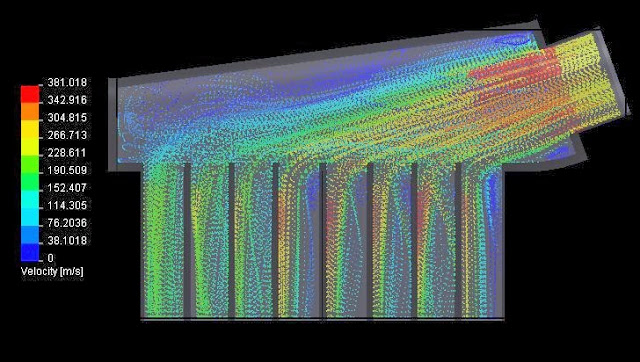When Derek at Exklusiv Motorsports brought up buying a manifold, I'll admit, it wasn't something I had in mind, especially when I associate manifolds and heads and big front mount intercoolers and big GT28 style turbos pushing 350whp in front wheel drive cars -- I'm not looking to generate that much power, nor do I like the look of a FMIC and it's piping. However, when Derek pointed out a small port ABD manifold on craigslist that promised an additional 12hp -at half the cost of retail- I had trouble saying no (right up until I started reading reviews).
ABD Intake Manifold
007 Intake Manifold
The problem with manifolds is that while they claim to generate power through airflow (which is true), you need the right amount of air, the right amount of room, and the means to disperse it evenly. Many people have thrown aftermarket manifolds on their cars and noticed no particular gains with the stock turbo (in this instance, the KO3S). Once upgrading the turbo setup the modifiers noticed an increase of induction at an exponential rate, leading anywhere from 7 to 30 to 50hp depending on their compressor and setup. However, while they're "performing" better than stock, it doesn't mean every port is getting the right amount of air.
Here's two very common styles I've found:
Reading these mixed reviews put a bad taste in my mouth for a manifold project. I could see the point in generating better numbers, but not if it meant driving around with one cylinder's air/ fuel mixture enriched while the one on the opposite end is gasping. I needed to find an alternative, and here it is. Enter the Dual Plenum Intake Manifold:
MR2 Gen 2 DPIM
The benefit of dual plenum lies in its cone shaped component. Air enters through the throttle body, into the cone and is spread out over all four runners.
The end result: controlled air velocity and even dispersal amongst all four runners:
But this didn't solve my problem. DPIM's are mostly custom projects, and none were available for me to buy. So after some brain storming, Derek came up with an AEB intake, which came off a Audi TT 1.8T. In the early 2000's, VW used a 1.8T motor which was also featured in the Audi TT. The exception being that Audi offered a 225 option which included larger ported exhaust and intake manifolds, bigger ports on the head (obviously) and a larger turbo. All these parts can be taken and swapped over to the VW model 1.8T, with modification.
Here's the stock AWP intake (top), and the AEB intake I purchased (bottom):
Apart from the runners being much longer, this size comparison shows a dramatic increase in port size between the two:
Jeff at Exklusiv custom-made manifolds for a living, and explained the process in detail. He would separate the runners from the plenum (already shown below), and the injector boss housings would be ground back to maximize airflow on the port end:
The 60mm 1.8T throttle body will be replaced with a 70mm R32 throttle body. You can read the comprehensive INA review here. Thanks AutoHaas LLC.!
Trumpet inlets on all four runners would be purchased and installed to ensure better air flow as well, via Nubwerks:
There's no room to build upward from the plenum in the engine bay (it could come in contact with the hood). The alternative would be to build the manifold with the dual plenum angled downward.
-----------------------------
Not very long ago, I purchased a PWRhaus side mount intercooler and silicone kit, like this one:
While I'm still trying to convince every 1.8T owner that upgrading the silicone throttle body hose is paramount for the first string of engine mods, it still doesn't conceal the fact that its shape is arguably an issue for airflow. The pipe wiggles its way around engine components and all those bends do little to help get air from the intercooler to the throttle body, and hence to the intake manifold.
Here's the stock throttle body hose on the 1.8T side mount intercooler, which sits on the passenger side of the car, in front of the wheel (although oddly positioned in the photo).
The hose runs vertically from the intercooler and bends in a semi-"s" shape to couple the throttle body, as seen below:
I still say the $90 solution for better throttle response is best, even with the "s" style shape, but shortening the length of the silicone/ rubber piping even more - now that would be nice.
-------------------------------
Since Jeff will be relocating the inlet plenum and VR6 throttle body to the underside, it should decrease the distance between said inlet and the side mount. How short you ask?
You'll have to come back and find out.
I can leave you with the list of upgrades we're shooting for so far:
1.8T AWP motor (port matched to intake/ exhaust manifold)
1.8T AWP fuel rail
1.8T AEB dual plenum intake manifold
1.8T AEB exhaust manifold
.:R32 70mm throttle body
PWRhaus turbo inlet pipe
PWRhaus side mount intercooler
Snow Performance Stage 2 water methanol injection
Frankenturbo F23T KO4 Hybrid
Frankenturbo high pressure fuel pump





















Thanks For sharing this Superb article.I use this Article to show my assignment in college.it is useful For me Great Work. OMC exhaust manifolds
ReplyDeleteVery interesting. Is one potential error that these CFD simulations assume all cylinders are breathing simultaneously when in reality only one cylinder is breathing at a time - (well maybe 1 and a bit with cam overlap) ? Ignoring RPM / resonances, how is breathing effected between runners depending on their physical position? The previous cylinder on intake might not be adjacent to the next one in the sequence?
ReplyDeleteGood article, but there are some things wrong. The 1,8T up to 150PS are the big ports. All above are small ports. 😉
ReplyDelete